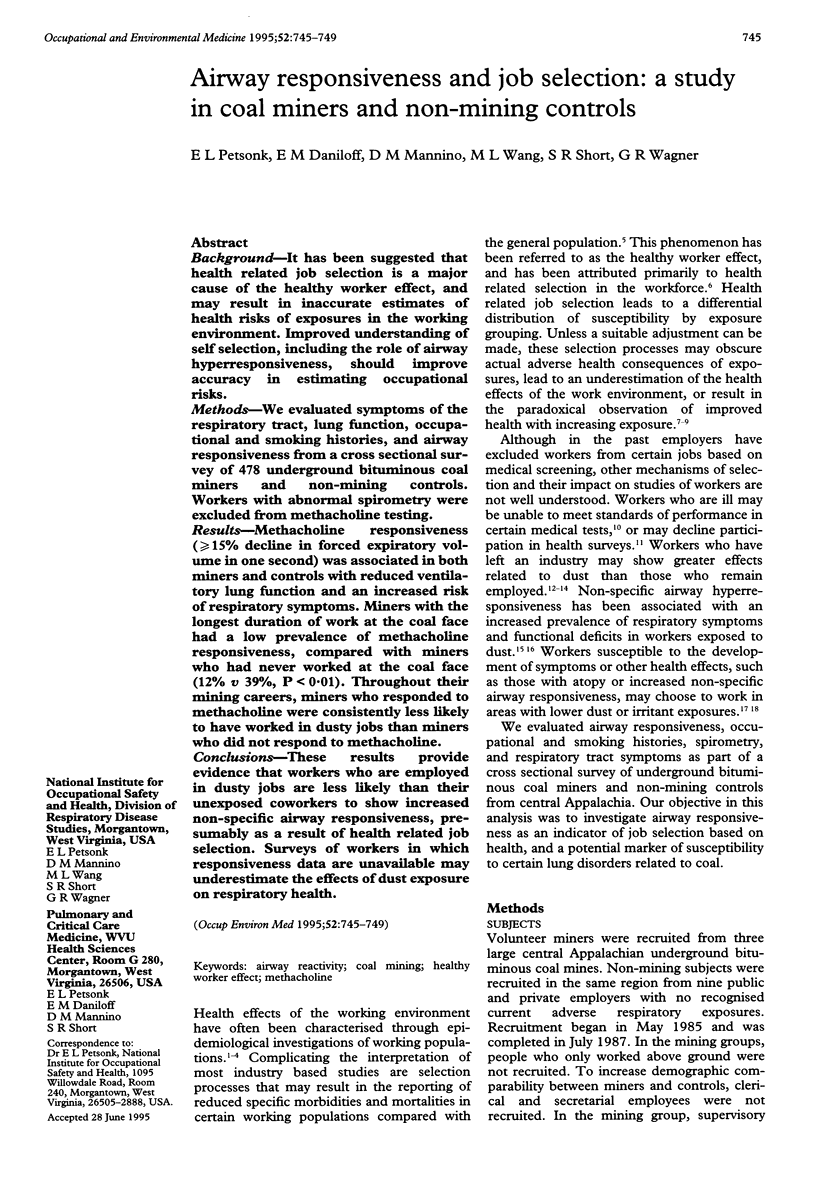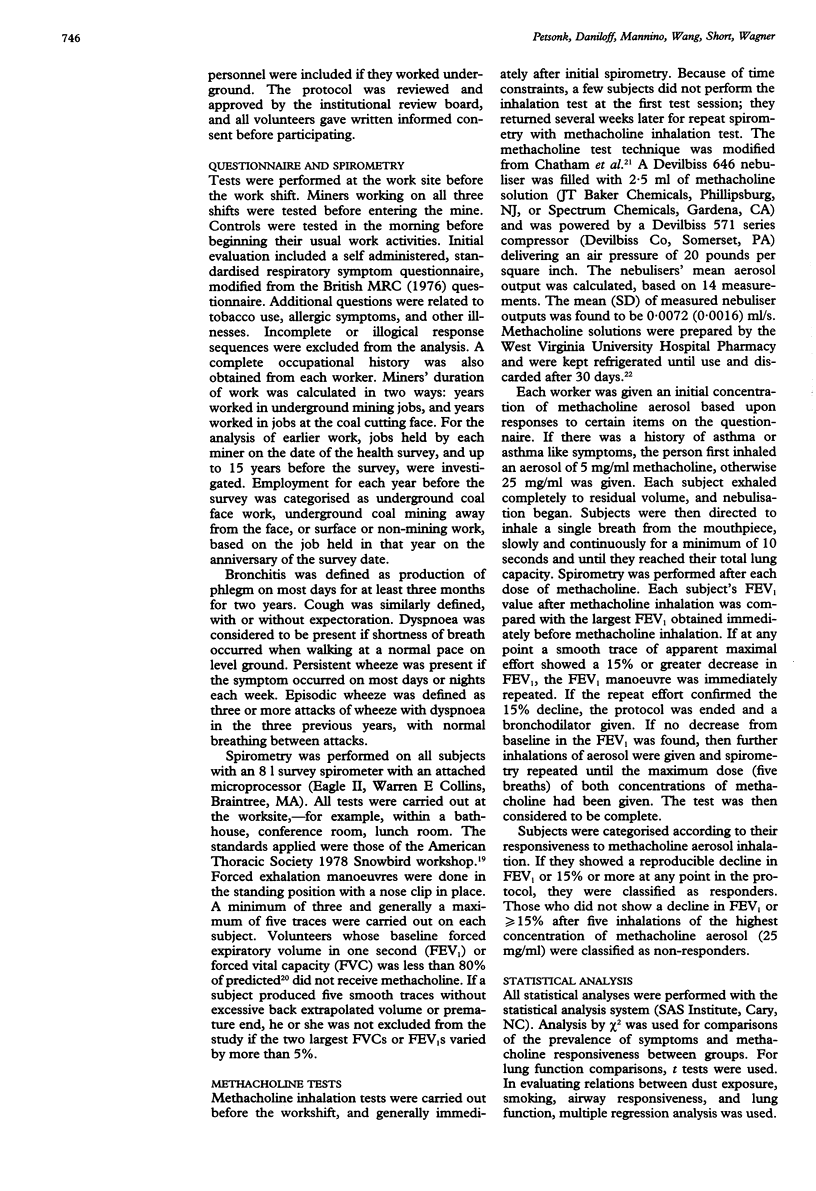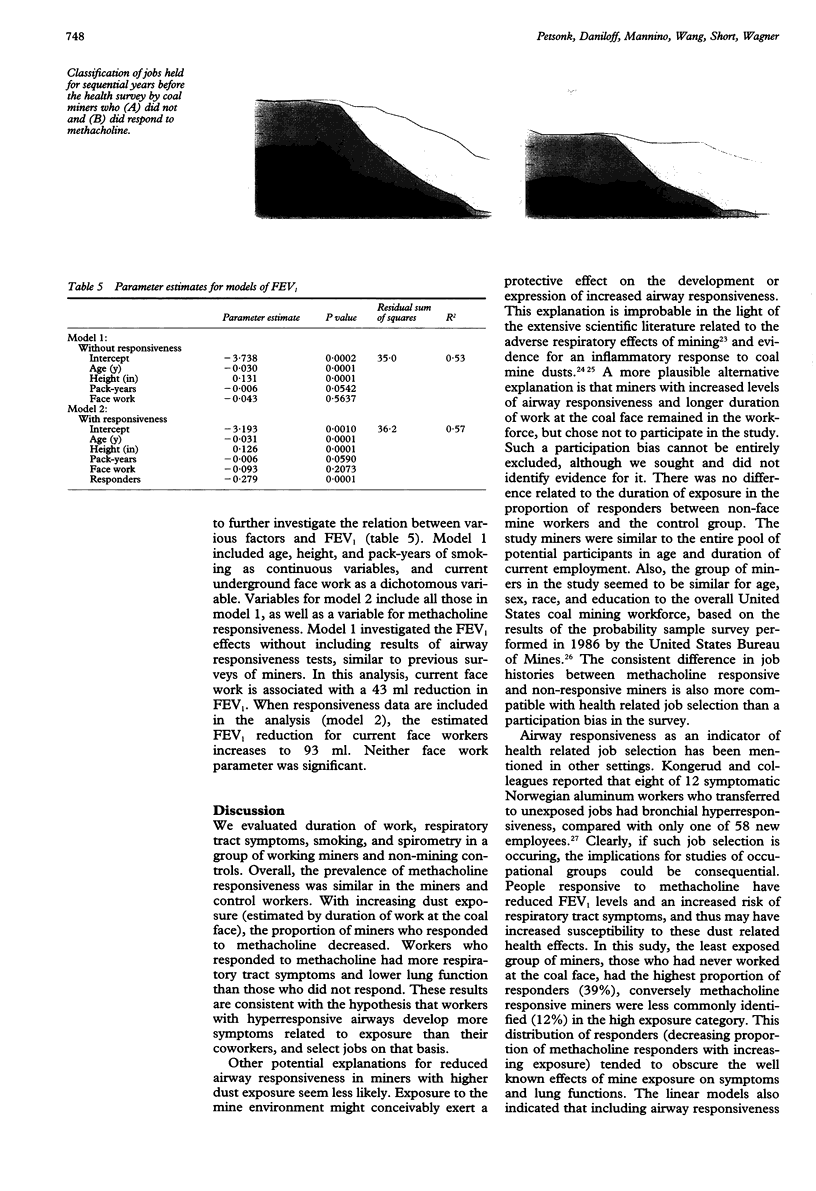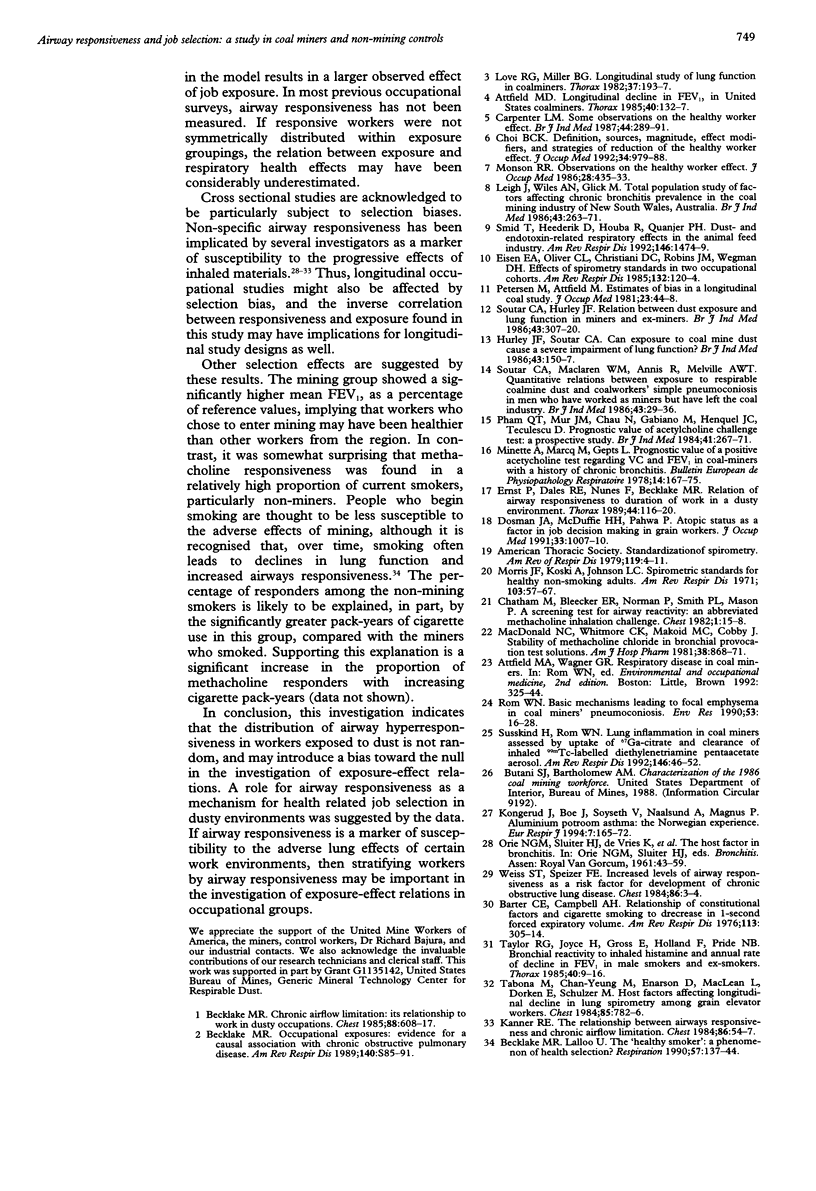Abstract
BACKGROUND--It has been suggested that health related job selection is a major cause of the healthy worker effect, and may result in inaccurate estimates of health risks of exposures in the working environment. Improved understanding of self selection, including the role of airway hyperresponsiveness, should improve accuracy in estimating occupational risks. METHODS--We evaluated symptoms of the respiratory tract, lung function, occupational and smoking histories, and airway responsiveness from a cross sectional survey of 478 underground bituminous coal miners and non-mining controls. Workers with abnormal spirometry were excluded from methacholine testing. RESULTS--Methacholine responsiveness (> or = 15% decline in forced expiratory volume in one second) was associated in both miners and controls with reduced ventilatory lung function and an increased risk of respiratory symptoms. Miners with the longest duration of work at the coal face had a low prevalence of methacholine responsiveness, compared with miners who had never worked at the coal face (12% v 39%, P < 0.01). Throughout their mining careers, miners who responded to methacholine were consistently less likely to have worked in dusty jobs than miners who did not respond to methacholine. CONCLUSIONS--These results provide evidence that workers who are employed in dusty jobs are less likely than their unexposed coworkers to show increased non-specific airway responsiveness, presumably as a result of health related job selection. Surveys of workers in which responsiveness data are unavailable may underestimate the effects of dust exposure on respiratory health.
Full text
PDF




Selected References
These references are in PubMed. This may not be the complete list of references from this article.
- Attfield M. D. Longitudinal decline in FEV1 in United States coalminers. Thorax. 1985 Feb;40(2):132–137. doi: 10.1136/thx.40.2.132. [DOI] [PMC free article] [PubMed] [Google Scholar]
- Barter C. E., Campbell A. H. Relationship of constitutional factors and cigarette smoking to decrease in 1-second forced expiratory volume. Am Rev Respir Dis. 1976 Mar;113(3):305–314. doi: 10.1164/arrd.1976.113.3.305. [DOI] [PubMed] [Google Scholar]
- Becklake M. R. Chronic airflow limitation: its relationship to work in dusty occupations. Chest. 1985 Oct;88(4):608–617. doi: 10.1378/chest.88.4.608. [DOI] [PubMed] [Google Scholar]
- Becklake M. R., Lalloo U. The 'healthy smoker': a phenomenon of health selection? Respiration. 1990;57(3):137–144. doi: 10.1159/000195837. [DOI] [PubMed] [Google Scholar]
- Becklake M. R. Occupational exposures: evidence for a causal association with chronic obstructive pulmonary disease. Am Rev Respir Dis. 1989 Sep;140(3 Pt 2):S85–S91. doi: 10.1164/ajrccm/140.3_Pt_2.S85. [DOI] [PubMed] [Google Scholar]
- Carpenter L. M. Some observations on the healthy worker effect. Br J Ind Med. 1987 May;44(5):289–291. doi: 10.1136/oem.44.5.289. [DOI] [PMC free article] [PubMed] [Google Scholar]
- Chatham M., Bleecker E. R., Norman P., Smith P. L., Mason P. A screening test for airways reactivity. An abbreviated methacholine inhalation challenge. Chest. 1982 Jul;82(1):15–18. doi: 10.1378/chest.82.1.15. [DOI] [PubMed] [Google Scholar]
- Choi B. C. Definition, sources, magnitude, effect modifiers, and strategies of reduction of the healthy worker effect. J Occup Med. 1992 Oct;34(10):979–988. [PubMed] [Google Scholar]
- Dosman J. A., McDuffie H. H., Pahwa P. Atopic status as a factor in job decision making in grain workers. J Occup Med. 1991 Sep;33(9):1007–1010. [PubMed] [Google Scholar]
- Eisen E. A., Oliver L. C., Christiani D. C., Robins J. M., Wegman D. H. Effects of spirometry standards in two occupational cohorts. Am Rev Respir Dis. 1985 Jul;132(1):120–124. doi: 10.1164/arrd.1985.132.1.120. [DOI] [PubMed] [Google Scholar]
- Ernst P., Dales R. E., Nunes F., Becklake M. R. Relation of airway responsiveness to duration of work in a dusty environment. Thorax. 1989 Feb;44(2):116–120. doi: 10.1136/thx.44.2.116. [DOI] [PMC free article] [PubMed] [Google Scholar]
- Hurley J. F., Soutar C. A. Can exposure to coalmine dust cause a severe impairment of lung function? Br J Ind Med. 1986 Mar;43(3):150–157. doi: 10.1136/oem.43.3.150. [DOI] [PMC free article] [PubMed] [Google Scholar]
- Kanner R. E. The relationship between airways responsiveness and chronic airflow limitation. Chest. 1984 Jul;86(1):54–57. doi: 10.1378/chest.86.1.54. [DOI] [PubMed] [Google Scholar]
- Kongerud J., Boe J., Søyseth V., Naalsund A., Magnus P. Aluminium potroom asthma: the Norwegian experience. Eur Respir J. 1994 Jan;7(1):165–172. doi: 10.1183/09031936.94.07010165. [DOI] [PubMed] [Google Scholar]
- Leigh J., Wiles A. N., Glick M. Total population study of factors affecting chronic bronchitis prevalence in the coal mining industry of New South Wales, Australia. Br J Ind Med. 1986 Apr;43(4):263–271. doi: 10.1136/oem.43.4.263. [DOI] [PMC free article] [PubMed] [Google Scholar]
- Love R. G., Miller B. G. Longitudinal study of lung function in coal-miners. Thorax. 1982 Mar;37(3):193–197. doi: 10.1136/thx.37.3.193. [DOI] [PMC free article] [PubMed] [Google Scholar]
- MacDonald N. C., Whitmore C. K., Makoid M. C., Cobby J. Stability of methacholine chloride in bronchial provocation test solutions. Am J Hosp Pharm. 1981 Jun;38(6):868–871. [PubMed] [Google Scholar]
- Minette A., Marcq M., Gepts L. Prognostic value of a positive acetylcholine test regarding VC and FEV1 in coal-miners with a history of chronic bronchitis. Bull Eur Physiopathol Respir. 1978 Mar-Apr;14(2):167–175. [PubMed] [Google Scholar]
- Morris J. F., Koski A., Johnson L. C. Spirometric standards for healthy nonsmoking adults. Am Rev Respir Dis. 1971 Jan;103(1):57–67. doi: 10.1164/arrd.1971.103.1.57. [DOI] [PubMed] [Google Scholar]
- Petersen M., Attfield M. Estimates of bias in a longitudinal coal study. J Occup Med. 1981 Jan;23(1):44–48. doi: 10.1097/00043764-198101000-00018. [DOI] [PubMed] [Google Scholar]
- Pham Q. T., Mur J. M., Chau N., Gabiano M., Henquel J. C., Teculescu D. Prognostic value of acetylcholine challenge test: a prospective study. Br J Ind Med. 1984 May;41(2):267–271. doi: 10.1136/oem.41.2.267. [DOI] [PMC free article] [PubMed] [Google Scholar]
- Rom W. N. Basic mechanisms leading to focal emphysema in coal workers' pneumoconiosis. Environ Res. 1990 Oct;53(1):16–28. doi: 10.1016/s0013-9351(05)80127-6. [DOI] [PubMed] [Google Scholar]
- Smid T., Heederik D., Houba R., Quanjer P. H. Dust- and endotoxin-related respiratory effects in the animal feed industry. Am Rev Respir Dis. 1992 Dec;146(6):1474–1479. doi: 10.1164/ajrccm/146.6.1474. [DOI] [PubMed] [Google Scholar]
- Soutar C. A., Hurley J. F. Relation between dust exposure and lung function in miners and ex-miners. Br J Ind Med. 1986 May;43(5):307–320. doi: 10.1136/oem.43.5.307. [DOI] [PMC free article] [PubMed] [Google Scholar]
- Soutar C. A., Maclaren W. M., Annis R., Melville A. W. Quantitative relations between exposure to respirable coalmine dust and coalworkers' simple pneumoconiosis in men who have worked as miners but have left the coal industry. Br J Ind Med. 1986 Jan;43(1):29–36. doi: 10.1136/oem.43.1.29. [DOI] [PMC free article] [PubMed] [Google Scholar]
- Susskind H., Rom W. N. Lung inflammation in coal miners assessed by uptake of 67Ga-citrate and clearance of inhaled 99mTc-labeled diethylenetriamine pentaacetate aerosol. Am Rev Respir Dis. 1992 Jul;146(1):47–52. doi: 10.1164/ajrccm/146.1.47. [DOI] [PubMed] [Google Scholar]
- Tabona M., Chan-Yeung M., Enarson D., MacLean L., Dorken E., Schulzer M. Host factors affecting longitudinal decline in lung spirometry among grain elevator workers. Chest. 1984 Jun;85(6):782–786. doi: 10.1378/chest.85.6.782. [DOI] [PubMed] [Google Scholar]
- Taylor R. G., Joyce H., Gross E., Holland F., Pride N. B. Bronchial reactivity to inhaled histamine and annual rate of decline in FEV1 in male smokers and ex-smokers. Thorax. 1985 Jan;40(1):9–16. doi: 10.1136/thx.40.1.9. [DOI] [PMC free article] [PubMed] [Google Scholar]
- Weiss S. T., Speizer F. E. Increased levels of airways responsiveness as a risk factor for development of chronic obstructive lung disease. What are the issues? Chest. 1984 Jul;86(1):3–4. doi: 10.1378/chest.86.1.3. [DOI] [PubMed] [Google Scholar]


